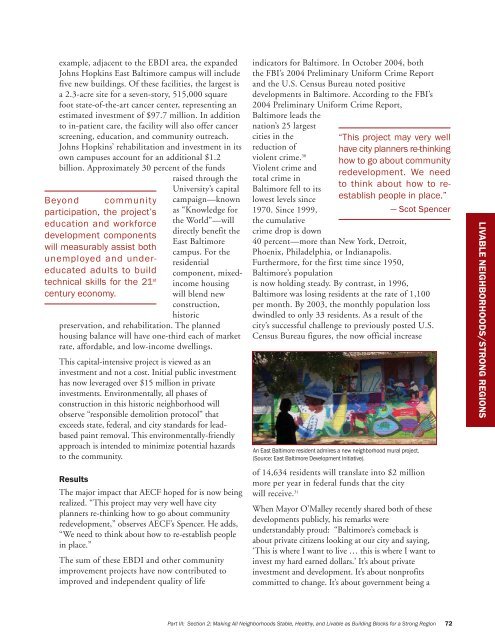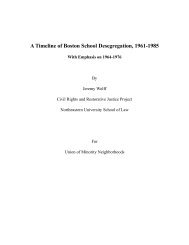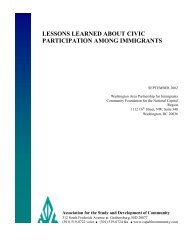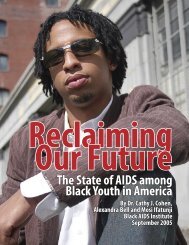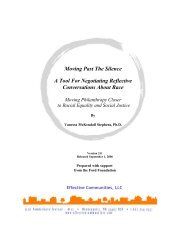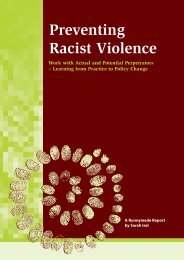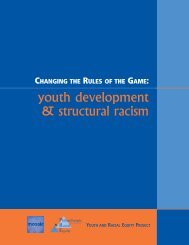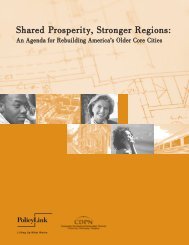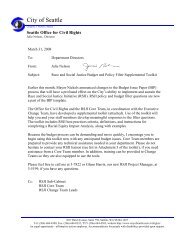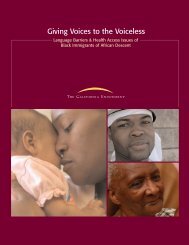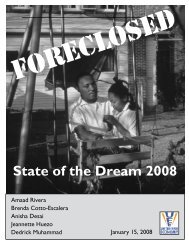Stories of Philanthropic Leadership in Advancing Regional and ...
Stories of Philanthropic Leadership in Advancing Regional and ...
Stories of Philanthropic Leadership in Advancing Regional and ...
Create successful ePaper yourself
Turn your PDF publications into a flip-book with our unique Google optimized e-Paper software.
example, adjacent to the EBDI area, the exp<strong>and</strong>edJohns Hopk<strong>in</strong>s East Baltimore campus will <strong>in</strong>cludefive new build<strong>in</strong>gs. Of these facilities, the largest isa 2.3-acre site for a seven-story, 515,000 squarefoot state-<strong>of</strong>-the-art cancer center, represent<strong>in</strong>g anestimated <strong>in</strong>vestment <strong>of</strong> $97.7 million. In additionto <strong>in</strong>-patient care, the facility will also <strong>of</strong>fer cancerscreen<strong>in</strong>g, education, <strong>and</strong> community outreach.Johns Hopk<strong>in</strong>s’ rehabilitation <strong>and</strong> <strong>in</strong>vestment <strong>in</strong> itsown campuses account for an additional $1.2billion. Approximately 30 percent <strong>of</strong> the fundsraised through theBeyond communityparticipation, the project’seducation <strong>and</strong> workforcedevelopment componentswill measurably assist bothunemployed <strong>and</strong> undereducatedadults to buildtechnical skills for the 21 stcentury economy.University’s capitalcampaign—knownas “Knowledge forthe World”—willdirectly benefit theEast Baltimorecampus. For theresidentialcomponent, mixed<strong>in</strong>comehous<strong>in</strong>gwill blend newconstruction,historicpreservation, <strong>and</strong> rehabilitation. The plannedhous<strong>in</strong>g balance will have one-third each <strong>of</strong> marketrate, affordable, <strong>and</strong> low-<strong>in</strong>come dwell<strong>in</strong>gs.This capital-<strong>in</strong>tensive project is viewed as an<strong>in</strong>vestment <strong>and</strong> not a cost. Initial public <strong>in</strong>vestmenthas now leveraged over $15 million <strong>in</strong> private<strong>in</strong>vestments. Environmentally, all phases <strong>of</strong>construction <strong>in</strong> this historic neighborhood willobserve “responsible demolition protocol” thatexceeds state, federal, <strong>and</strong> city st<strong>and</strong>ards for leadbasedpa<strong>in</strong>t removal. This environmentally-friendlyapproach is <strong>in</strong>tended to m<strong>in</strong>imize potential hazardsto the community.ResultsThe major impact that AECF hoped for is now be<strong>in</strong>grealized. “This project may very well have cityplanners re-th<strong>in</strong>k<strong>in</strong>g how to go about communityredevelopment,” observes AECF’s Spencer. He adds,“We need to th<strong>in</strong>k about how to re-establish people<strong>in</strong> place.”The sum <strong>of</strong> these EBDI <strong>and</strong> other communityimprovement projects have now contributed toimproved <strong>and</strong> <strong>in</strong>dependent quality <strong>of</strong> life<strong>in</strong>dicators for Baltimore. In October 2004, boththe FBI’s 2004 Prelim<strong>in</strong>ary Uniform Crime Report<strong>and</strong> the U.S. Census Bureau noted positivedevelopments <strong>in</strong> Baltimore. Accord<strong>in</strong>g to the FBI’s2004 Prelim<strong>in</strong>ary Uniform Crime Report,Baltimore leads thenation’s 25 largestcities <strong>in</strong> the “This project may very wellreduction <strong>of</strong> have city planners re-th<strong>in</strong>k<strong>in</strong>gviolent crime. 30how to go about communityViolent crime <strong>and</strong>redevelopment. We needtotal crime <strong>in</strong>to th<strong>in</strong>k about how to reestablishpeople <strong>in</strong> place.”Baltimore fell to itslowest levels s<strong>in</strong>ce1970. S<strong>in</strong>ce 1999,— Scot Spencerthe cumulativecrime drop is down40 percent—more than New York, Detroit,Phoenix, Philadelphia, or Indianapolis.Furthermore, for the first time s<strong>in</strong>ce 1950,Baltimore’s populationis now hold<strong>in</strong>g steady. By contrast, <strong>in</strong> 1996,Baltimore was los<strong>in</strong>g residents at the rate <strong>of</strong> 1,100per month. By 2003, the monthly population lossdw<strong>in</strong>dled to only 33 residents. As a result <strong>of</strong> thecity’s successful challenge to previously posted U.S.Census Bureau figures, the now <strong>of</strong>ficial <strong>in</strong>creaseAn East Baltimore resident admires a new neighborhood mural project.(Source: East Baltimore Development Initiative).<strong>of</strong> 14,634 residents will translate <strong>in</strong>to $2 millionmore per year <strong>in</strong> federal funds that the citywill receive. 31When Mayor O’Malley recently shared both <strong>of</strong> thesedevelopments publicly, his remarks wereunderst<strong>and</strong>ably proud: “Baltimore’s comeback isabout private citizens look<strong>in</strong>g at our city <strong>and</strong> say<strong>in</strong>g,‘This is where I want to live … this is where I want to<strong>in</strong>vest my hard earned dollars.’ It’s about private<strong>in</strong>vestment <strong>and</strong> development. It’s about nonpr<strong>of</strong>itscommitted to change. It’s about government be<strong>in</strong>g aLIVABLE NEIGHBORHOODS/STRONG REGIONSPart III: Section 2: Mak<strong>in</strong>g All Neighborhoods Stable, Healthy, <strong>and</strong> Livable as Build<strong>in</strong>g Blocks for a Strong Region 72


